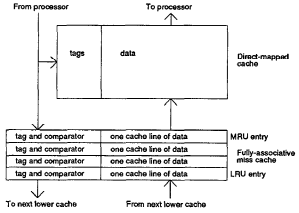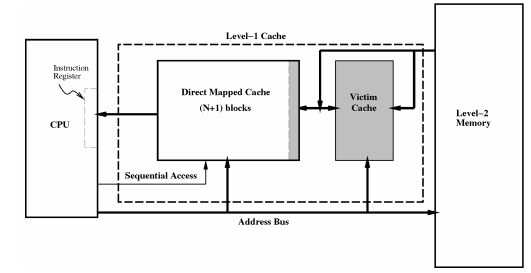CSC 456 Fall 2013/1b ra
Sector Cache
Sectored caching was one type of early CPU cache organization that has risen and fallen in popularity over the years. Sectored caching involves dividing a cache up into sectors to allow for faster searching and more efficient use of space than some other cache organizations.
Background
IBM Model 85
Sectored caching was first used on the IBM System/360 Model 85, which was the earliest commercial system that used a CPU data cache of any kind. Sectored caching allowed for smaller tag sizes in the addresses, which made searching in cache easier and quicker, without requiring cache lines to be excessively long; and it was easier to build than other kinds of cache organizations with the circuit technology of the time. <ref name="Rothman">Rothman, Jeffrey B. and Alan Jay Smith. Sector Cache Design and Performance. http://www.eecs.berkeley.edu/Pubs/TechRpts/1999/CSD-99-1034.pdf
</ref> Released in 1968, the Model 85 was one of the first computers to have a CPU data cache, which at the time was known as "buffer storage", come as a standard feature. As with most caches, the cache on the Model 85 attempts to fetch data from the cache first before fetching from main memory. This allowed for much faster data fetching and storage, reducing the average system storage cycle time to about one third or one quarter what it would be if using main memory alone. <ref name="IBM">IBM. IBM System/360 Model 85 Functional Characteristics. http://www.bitsavers.org/pdf/ibm/360/funcChar/A22-6916-1_360-85_funcChar_Jun68.pdf Template:Cite manual </ref> This new type of cache organization represented a significant departure from cache organizations used previously in the IBM System/360 line of computers. In testing during the design of the Model 85, it was found to run at 81% of the maximum ideal efficiency calculated by IBM's designers. <ref name="Liptay">Liptay, J. S. Structural Aspects of the System/360 Model 85, Part II: The Cache. http://ieeexplore.ieee.org/stamp/stamp.jsp?tp=&arnumber=5388402&isnumber=5388400
</ref> After the release of the Model 85, however, it soon became clear that sectored caching was less effective than set-associative caching for computer and chip architectures at that time and fell out of common use.<ref name="Rothman"/>
Reappearance
In a 1999 article, Alan Jay Smith and Jeffrey B. Rothman revisited the idea of sectored caching to determine if changes in technology from 1968 had made sectored caching useful. They looked at whether there would be any performance gain if sectored caching was used in multi-level cache architectures.
One early cache organization technique was sector cache. It was used on the IBM 360/85, which was one of the earliest commercial CPUs<ref name="rot99">Rothman, Jeffrey B. and Alan Jay Smith. Sector Cache Design and Performance</ref>. Sector cache allowed for smaller tag sizes, which made searching in cache easier and quicker, without requiring cache lines to be excessively long.<ref name="rot99"/> It was also easier to build with the circuit technology of the time.<ref name="rot99"/> In testing during the design of the IBM 360/85, it was found to run at 81% of the maximum ideal efficiency calculated by IBM's designers.<ref name="lip68">Liptay, J. S. Structural Aspects of the System/360 Model 85, Part II: The Cache.</ref> Sector caches were later replaced by set associative caches, which were found to be more efficient.<ref name="rot99"/>
[Old work]
Organization
[New stuff here]

The cache is divided into sectors, which correspond to logical sectors on the main storage device.<ref name="lip68"/> When sectors are needed, they are not loaded into cache all at once, but in smaller pieces known as subsectors.<ref name="lip68"/> Subsectors are similar to the lines in a direct mapped cache, and are only loaded into cache when needed. This prevents large amounts of data from having to be transferred for every memory reference. Subsectors have a validity bit that indicates whether they are loaded with data or not.<ref name="lip68"/>
[Old work]
Implementation
[New stuff here]
Advantages/Disadvantages
[New stuff here]
Miss Handling
[New stuff here]
When a process requests data from a disk sector that is not in the cache, a cache sector is assigned to the sector on the main storage device where the requested data is stored.<ref name="lip68"/> Then the subsector where the data is located is loaded into the cache. The subsector's validity bit is then set to reflect that it has been loaded from the main storage.<ref name="lip68"/> When data from other subsectors within a loaded sector are requested, the system loads those subsectors into the cache sector and sets their validity bits.<ref name="lip68"/> Sectors are not removed from the cache until the system needs to reclaim the space to process another request.<ref name="lip68"/>
[Old work]
Architectures
[New stuff here]
Parameters
[New stuff here]
Evolution
[New stuff here]
Victim Cache
Background
Victim caches were first proposed by Norman P. Jouppi in 1990. Victim caching implements a small, fully-associative cache between direct-mapped L1 memory and the next level of memory. The cache allows lines evicted from the L1 cache a “second-chance” by loading them into the victim cache. Victim caches decrease the overall conflict miss rate <ref name="Jouppi">Jouppi, Norman P. Improving direct-mapped cache performance by the addition of a small fully-associative cache and prefetch buffers. http://ieeexplore.ieee.org/xpl/freeabs_all.jsp?arnumber=134547
</ref>. Direct-mapped caches can especially benefit from victim caching due to their large miss rates. Victim caching allows direct-mapped caches to still be used in order to take advantage of their speed while decreasing the miss rate to an even lower rate than the miss rate found in set-associative caches <ref name = "Jouppi"/>.
Victim caches were first proposed by Norman P. Jouppi in 1990 at the 17th Annual International Symposium on Computer Architecture. During this time the performance of processors was increasing drastically, however memory hierarchies had not advanced in the same manner. Jouppi observed that if this trend continued the newer machines would easily lose half of their potential performance due to the short comings of the state of memory hierarchy at the time. This is illustrated in the figure(Figure 2.1) below which is from Jouppi's 1990 paper.which shows how the cost of cache misses was dramatically increasing<ref name = "Jouppi"/>.

Organization
Victim Cache
In order for a system to use a victim cache it needs to be use a direct-mapping cache system. Victim caching is a technique of optimizing the use of a miss cache<ref name = "Jouppi"/>. A miss cache is a small on-chip cache between the first-level cache and the access point to the second-level cache<ref name = "Jouppi"/>. The miss cache would typically store two to five lines, when a miss would occur the data would not only be loaded into the direct-mapped cache but also into the miss cache replacing the least recently used item<ref name = "Jouppi"/>. While this did help with reducing the amount of conflict misses the optimization of that small cache was not very good considering it could have a lot of the same lines in the direct-mapped cache. The organization of the miss cache can be seen below in the Figure 2.2 which was shown in the 1990 paper by Jouppi<ref name = "Jouppi"/>.

Selective Victim Cache
An improvement made upon the victim caching technique came from Stiliadis and Verma in 1997 with their introduction of selective victim caching in 1997 <ref name="Verma">Dimitrios Stiliadis and Anujan Verma. Selective Victim Caching: A Method to Improve the Performance of Direct-Mapped Caches. http://ieeexplore.ieee.org.prox.lib.ncsu.edu/xpl/articleDetails.jsp?arnumber=589235&tag=1
</ref>. This cache management organization is similar to the initial victim cache system proposed by Jouppi but instead of the pushing replaced block into the victim and automatically interchanging between the two if the main cache need a block it uses a prediction algorithm based on the past usage of the block<ref name = "Verma"/>. This is accomplished by adding an additional block to the main cache called the "transitory block"<ref name="Verma"/>. This block in the main cache is used both predict sequential references by determining repeated patterns of access and act as a buffer between the main and victim caches during an interchange to predict if it is necessary<ref name = "Verma"/>. The below figure(Figure 2.3) shows a Sequential State Machine that switches between the normal state which is when the memory is decoded from the main cache and the special state which is when access is directed towards the transitory block<ref name="Verma"/>.

The other important function of the algorithm is the cache block swapping prediction based on past usage. This is used when a miss occurs in the main cache but the block is found in the victim cache. The first step is to load the block into the transitory block<ref name = "Verma"/>. The algorithm then looks at the prediction bits in the transitory block and compares them to those found in the block store in the main cache<ref name="Verma"/>. If the blocks in the main cache are more likely to be used again before the buffered block the block in the transitory section is accessed and then sent back to the victim cache<ref name = "Verma"/>. If the block is more likely to be accessed again than another block in the main cache the normal victim cache swapping occurs<ref name = "Verma"/>. This process can be seen in the figure(Figure 2.4) below which illustrates the movement of memory blocks between the level-one cache,the victim cache, the CPU, and the level-two cache<ref name = "Verma"/>. In the paper by Stiliadis and Verma they showed that this new modification to the victim caching set-up improved performance in both smaller and larger cache size. For example when a simulation was run using ten instruction traces it showed an average improvement of 21% in miss rates and 70% reduction in exchanges between the main and victim caches<ref name="Verma"/>.

Evolution
Advantages/Disadvantages
Architectures
Victim caching can be found in AMD's Opteron processor series produced specifically for servers and workstations. <ref>http://en.wikipedia.org/wiki/Opteron</ref> Opteron processors use a victim cache that is capable of holding eight victim blocks. <ref> Hennessy, John L., and David A. Patterson. Computer Architecture: A Quantitative Approach. Elsevier, Inc., 2012, p. B-14.</ref>
Parameters
Evolution
References
<references />
Topic 1b: Sectored Caches & Victim Caches
Sectored Cache:
Links: Wikipedia page saying IBM 360/85 --Taolande 11:31, 3 September 2013 (EDT)